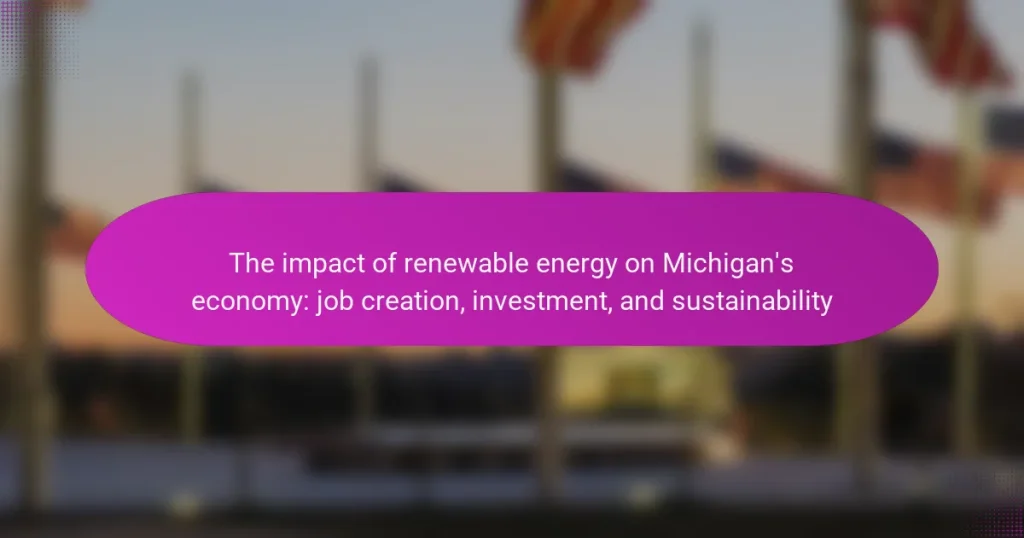
What is the impact of renewable energy on Michigan’s economy?
Renewable energy positively impacts Michigan’s economy by creating jobs and attracting investment. The renewable sector has generated over 100,000 jobs in the state. Wind and solar industries contribute significantly to this employment growth. Investment in renewable energy reached approximately $1.8 billion in 2020 alone. This influx of capital supports local businesses and infrastructure development. Additionally, renewable energy projects lead to long-term savings on energy costs for consumers and businesses. The shift towards clean energy also enhances Michigan’s sustainability efforts, reducing greenhouse gas emissions. Overall, renewable energy fosters economic growth while promoting environmental responsibility.
How does renewable energy contribute to job creation in Michigan?
Renewable energy significantly contributes to job creation in Michigan through various sectors. The growth of wind and solar energy projects has led to increased demand for skilled labor. According to the U.S. Bureau of Labor Statistics, jobs in the renewable energy sector are projected to grow by 11% by 2026. In Michigan, over 100,000 jobs are tied to the clean energy economy. The state has invested in training programs to equip workers with necessary skills. Local manufacturing of solar panels and wind turbines creates additional employment opportunities. Moreover, renewable energy projects stimulate local economies by creating jobs in installation and maintenance. These factors collectively enhance Michigan’s workforce and economic stability.
What types of jobs are created by the renewable energy sector?
The renewable energy sector creates a variety of jobs across multiple disciplines. These include positions in solar energy installation, wind turbine manufacturing, and maintenance. Additionally, there are roles in energy efficiency consulting and project management. Research indicates that the sector has generated over 250,000 jobs in the U.S. alone as of 2021. This growth is driven by increasing investments in clean energy technologies. The jobs often require specialized training and skills. Many positions also contribute to local economies through community engagement and development. Overall, the renewable energy sector plays a crucial role in job creation and economic sustainability.
How does the growth of renewable energy jobs compare to traditional energy jobs?
The growth of renewable energy jobs significantly outpaces traditional energy jobs. According to the U.S. Bureau of Labor Statistics, employment in renewable energy sectors, such as solar and wind, is projected to grow by 61% from 2019 to 2029. In contrast, jobs in traditional energy sectors, like coal and oil, are expected to decline due to automation and environmental regulations. For instance, the solar industry alone added over 250,000 jobs in the past decade, while coal jobs have decreased by nearly 50% since 2011. This trend reflects a shift towards sustainable energy sources in response to climate change and market demands.
What role does investment play in the growth of renewable energy in Michigan?
Investment is crucial for the growth of renewable energy in Michigan. It provides the necessary capital for developing infrastructure, such as wind and solar farms. Increased funding leads to technological advancements, making renewable energy more efficient and cost-effective. According to the Michigan Energy Innovation Business Council, investments in renewable energy create jobs and stimulate local economies. In 2020, Michigan saw over $1.5 billion in investments in renewable energy projects. This financial support helps meet state energy goals and reduces reliance on fossil fuels. Overall, investment drives the transition to a sustainable energy future in Michigan.
What are the key areas of investment in renewable energy?
Key areas of investment in renewable energy include solar power, wind energy, energy storage, and bioenergy. Solar power investments focus on photovoltaic systems and solar thermal technologies. Wind energy investments target onshore and offshore wind farms. Energy storage investments enhance grid reliability through battery technologies and pumped hydro storage. Bioenergy investments involve biomass, biogas, and biofuels. According to the International Renewable Energy Agency, global renewable energy investment reached $281 billion in 2020, reflecting significant growth across these sectors.
How do state and federal policies influence renewable energy investment?
State and federal policies significantly influence renewable energy investment by providing financial incentives and regulatory frameworks. These policies include tax credits, grants, and subsidies that lower the cost of renewable energy projects. For example, the federal Investment Tax Credit (ITC) allows investors to deduct a significant percentage of installation costs from their federal taxes. Additionally, state-level Renewable Portfolio Standards (RPS) mandate a certain percentage of energy to come from renewable sources, driving investment in those technologies.
Policies also shape market stability and investor confidence. Clear and consistent regulations can attract private investment by reducing perceived risks. In Michigan, the state’s commitment to renewable energy goals has led to increased investments in solar and wind projects. According to a report from the Michigan Energy Innovation Business Council, the renewable energy sector has created thousands of jobs and attracted billions in investment since the implementation of supportive policies.
Moreover, federal initiatives like the Clean Power Plan aim to reduce carbon emissions, which encourages states to invest in cleaner energy sources. This creates a competitive market for renewable energy technologies, fostering innovation and driving down costs. Overall, effective state and federal policies are crucial in shaping the landscape for renewable energy investment.
Why is sustainability important for Michigan’s economic future?
Sustainability is crucial for Michigan’s economic future because it drives innovation and job creation. The transition to renewable energy sources can create over 60,000 jobs in Michigan by 2030. Sustainable practices reduce operational costs for businesses, enhancing their competitiveness. Additionally, investments in green technology attract funding and stimulate local economies. Michigan’s natural resources, such as wind and solar, provide a foundation for sustainable energy development. This shift can also lead to long-term energy security, reducing dependence on fossil fuels. Overall, sustainability fosters a resilient economy that can adapt to changing environmental conditions.
How does renewable energy contribute to environmental sustainability?
Renewable energy contributes to environmental sustainability by reducing greenhouse gas emissions. This shift decreases air pollution and mitigates climate change effects. For example, solar and wind energy produce electricity without emitting carbon dioxide. According to the International Energy Agency, renewables accounted for nearly 30% of global electricity generation in 2020. This transition supports biodiversity by minimizing habitat destruction associated with fossil fuel extraction. Furthermore, renewable energy systems often require less water than conventional energy sources. In Michigan, increased reliance on renewables can lead to cleaner air and improved public health outcomes. Overall, renewable energy plays a critical role in fostering a sustainable environment.
What are the long-term economic benefits of sustainability initiatives?
Sustainability initiatives provide long-term economic benefits by reducing operational costs and fostering innovation. Companies adopting sustainable practices often experience lower energy and resource expenses. For instance, businesses that implement energy-efficient technologies can save up to 30% on utility bills. Additionally, sustainability initiatives attract investment. According to a 2021 report by McKinsey, sustainable companies often see higher stock performance and lower capital costs. Job creation is another significant benefit. The renewable energy sector alone has created over 11 million jobs globally as of 2021. Furthermore, sustainability initiatives can enhance brand reputation and customer loyalty, leading to increased sales and market share. These factors collectively contribute to a resilient economy and long-term profitability.
How do job creation and investment in renewable energy intersect?
Job creation and investment in renewable energy intersect through the development of new industries and job opportunities. Investments in renewable energy lead to the establishment of solar, wind, and other clean energy sectors. These sectors require a skilled workforce, resulting in job creation in manufacturing, installation, and maintenance. According to the U.S. Bureau of Labor Statistics, jobs in renewable energy are projected to grow significantly faster than the average for all occupations. For instance, solar photovoltaic installers and wind turbine technicians are among the fastest-growing job roles. Additionally, investment in renewable energy projects stimulates local economies, fostering further job opportunities in supporting industries. The Renewable Energy and Jobs Annual Review 2021 by the International Renewable Energy Agency reported that the renewable energy sector employed over 11 million people globally, highlighting the strong link between investment and job creation.
What challenges does Michigan face in transitioning to renewable energy?
Michigan faces several challenges in transitioning to renewable energy. One significant challenge is the aging infrastructure of the energy grid. This infrastructure requires upgrades to accommodate renewable energy sources. Additionally, there is a need for substantial investment in new technologies. The cost of transitioning can be a barrier for both public and private sectors.
Another challenge is the regulatory environment. Existing regulations may not support rapid deployment of renewable energy projects. Furthermore, there is a need for workforce development. The transition requires skilled workers in renewable energy technologies.
Public acceptance is also crucial. Some communities may resist changes due to concerns about land use or aesthetics. Finally, Michigan’s climate can impact renewable energy generation. Seasonal variations affect solar and wind energy production. These challenges must be addressed for a successful transition to renewable energy in Michigan.
What best practices can Michigan adopt to maximize the benefits of renewable energy?
Michigan can maximize the benefits of renewable energy by implementing policies that promote investment and job creation. Establishing a robust renewable energy portfolio standard can encourage utilities to source more energy from renewables. This standard can drive innovation and lower costs in the renewable sector. Investing in workforce training programs will prepare residents for jobs in the growing renewable energy industry. Additionally, incentivizing local manufacturing of renewable energy components can enhance economic growth. Michigan can also expand community solar programs to increase access to renewable energy for all residents. Collaborating with universities for research and development can lead to new technologies in renewable energy. Finally, promoting energy efficiency programs can complement renewable energy initiatives, leading to overall reduced energy costs.
How can local businesses leverage renewable energy for growth?
Local businesses can leverage renewable energy for growth by reducing operational costs and enhancing sustainability. Utilizing solar panels and wind turbines can lower electricity expenses significantly. According to the U.S. Department of Energy, businesses that adopt renewable energy sources can save up to 75% on energy costs over time. Additionally, businesses can attract environmentally conscious consumers by promoting their use of green energy. This can lead to increased sales and customer loyalty. Furthermore, renewable energy projects can create local jobs, contributing to the economy. A report by the Michigan Energy Innovation Business Council states that the renewable energy sector has created thousands of jobs in Michigan, fostering economic growth.
What community initiatives support renewable energy adoption?
Community initiatives that support renewable energy adoption include local solar co-ops, community wind projects, and energy efficiency programs. Solar co-ops enable residents to collectively purchase solar panels, reducing costs and increasing installation rates. Community wind projects allow local stakeholders to invest in wind energy, fostering economic development. Energy efficiency programs provide resources and incentives for homes and businesses to reduce energy consumption. In Michigan, initiatives like the Michigan Saves program offer low-interest loans for energy upgrades. These efforts contribute to job creation and sustainable economic growth in the region.
The main entity of this article is renewable energy and its impact on Michigan’s economy. The article outlines how renewable energy contributes to job creation, with over 100,000 jobs generated in the sector, and highlights significant investments, totaling approximately $1.8 billion in 2020. It discusses the types of jobs created, compares growth in renewable energy jobs to traditional energy jobs, and emphasizes the importance of state and federal policies in driving investment. Furthermore, it addresses the challenges Michigan faces in transitioning to renewable energy and suggests best practices for maximizing benefits, including community initiatives that support renewable energy adoption.


